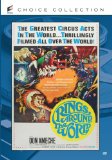| Reviews & Columns |
|
Reviews DVD TV on DVD Blu-ray 4K UHD International DVDs In Theaters Reviews by Studio Video Games Features Collector Series DVDs Easter Egg Database Interviews DVD Talk Radio Feature Articles Columns Anime Talk DVD Savant Horror DVDs The M.O.D. Squad Art House HD Talk Silent DVD
|
DVD Talk Forum |
|
|
| Resources |
|
DVD Price Search Customer Service #'s RCE Info Links |
|
Columns
|
|
|
Rings Around the World (Sony Choice Collection)
Despite the silly construction, some solid old-school circus thrills. Sony Pictures' Choice Collection line of hard-to-find library and cult titles has released Rings Around the World, the 1966 circus documentary featuring some of the greatest acts then working under the big top: Rudy Cardenas, The Larible Trapeze Act, La Mara, Marco, Mendez and Seitz, Pablo Noel, Pauline Schumann, Lilly Yokoi, The Tongas, Gunther Gebel-Williams, and more. A big-screen quasi-version of NBC's European-shot International Showtime TV variety series, Rings Around the World also features International's emcee, Don Ameche. Unlike his hosting gig for that series, though, where he appeared as himself, here in Rings Around the World, Ameche is clumsily inserted as a fictional author musing and writing about the circus--all completely unnecessary when we're given such spectacular big-top action. No extras for this okay fullscreen ColumbiaColor transfer.
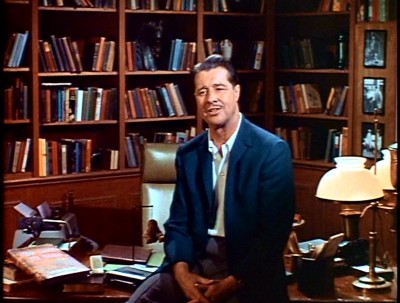
International Showtime, which ran from 1961 to 1965 on NBC, was rather unique at its time in that it was videotaped almost entirely overseas in cities like Stockholm and Munich, capturing acts from the great European circuses, ice shows, and other one-off entertainment spectaculars. Though never a big ratings success (it never broke through the Nielsen Top Thirty), it must have had some kind of family audience on Friday nights at 7:30 to keep it going for four years (I would imagine its nominal production costs--no sets, scripts, props, or actors--made the low ratings more tolerable: travel expenses were probably its biggest line item). In the weekly series, former big-screen idol Don Ameche appeared as himself, sitting ringside while introducing the acts, with occasional interviews conducted by him interspersed between the performances. In Rings Around the World, though, Ameche is fictional author "John Shawcross," seated in a two-flat "writer's office" mock-up set, dictating into a tape machine his wonderings about what makes circus performers do what they do. Narrating over the filmed (not taped) circus footage, "Shawcross" occasionally comes back to further marvel and ponder over these daredevils, as if he's finishing up the notes for his latest book.
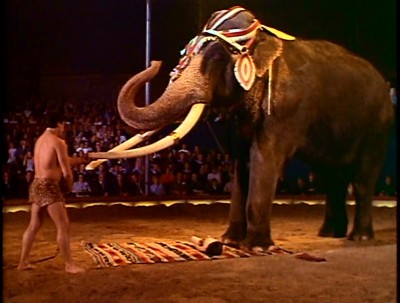
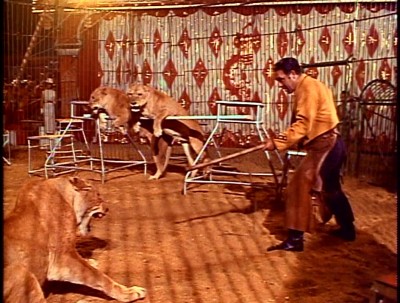
All of this, of course, is completely unnecessary. Why this awkward bookending was thought necessary is anybody's guess, but I suppose the producers somehow felt a straight documentary approach wouldn't work (Ameche just narrating), nor would a retread of the TV series' structure do, either (Ameche appearing as an emcee or ringleader, as many sources for Rings Around the World incorrectly identify him doing here). As the nominal "name" of the production (Ameche was all but forgotten by most moviegoers at this point in his career...but he was still a bigger "name" to general audiences compared to his circus performer costars), Ameche had to get screen time some way, so...this clumsy framework was invented by screenwriter Victor Wolfson (Suspense, Alfred Hitchcock Presents), and rather flatly put over by director Gilbert Cates (I Never Sang for My Father, Summer Wishes, Winter Dreams, and many TV movies like To All My Friends on Shore). Ameche, naturally, is fine in this thankless role, delivering impassioned, overripe observations like, "What crazy compulsion drives her day after day to tease the Angel of Death?" or "If startled or annoyed, he [an elephant] will kill. Without hesitation...he will kill," with far more straight-faced sincerity than they frankly deserve. However, the minute the actual circus footage comes up, shot in nerve-wracking close-up (you'd never see this stuff in the stalls), you pretty much forget all the phony dramatic framing.
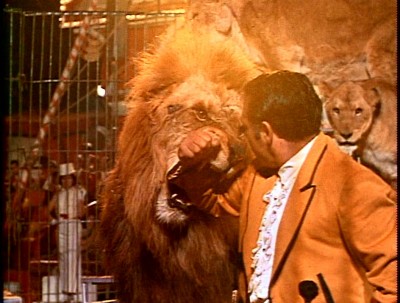
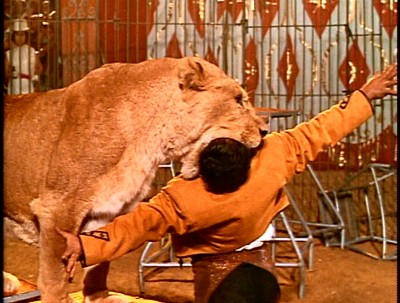
And what footage it is. Now, call me old-fashioned, but I grew up on circus performers who had guts. No nets. No safety harnesses. No doped-up "ferocious" animals. When they went out on that trapeze or high-wire or in that lion cage, you knew they were risking their lives to put on a show for you. Courage and skill were entwined, with the performers routinely cheating death the ultimate expression of their talents (a point made continually in Rings Around the World). About the last goddamned thing I want to do today is silently sit in a legitimate theater (of all places), respectfully watching Cirque du So Lame performers prance around like the road company of Cats as they're pulled along on their safety harnesses. That's the circus? No, I want to smell that sweet sawdust and feel the heat from the spectators and the lights rise and gather in that heavy, creaking canvas tent. I want to hear the barkers hawking popcorn and souvenirs while I'm cracking peanuts and gnawing on a candied apple, bumping shoulders with the guy on the wooden bench next to me, both of us momentarily transfixed by the wonderment of whether or not that gorgeous tightrope walker is going to slip and fall, or if that enraged lion is finally going to take one too many pokings and proddings and beatings, and score one for the harnessed and the tamed and the humiliated by zapping his tormentor with one flick of his meaty paw. Gaudy spectacle masking the ever-present possibility of sudden, gory death--now that's a circus, for christ's sake, not the safety-first, PETA-last sad imitations foisted on us now.
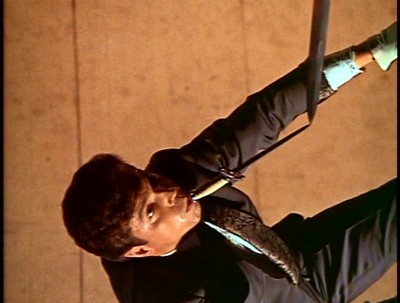
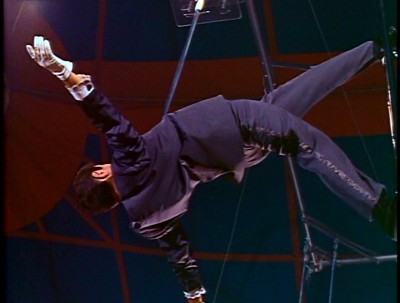
You can't get a better example of that kind of real circus than Rings Around the World's first act, La Mara, the stunningly beautiful, delightfully imperious superstar of the trapeze, whose rippling muscles and corded veins stand out as she hangs first by her neck, and then by the backs of her heels, without a net, fifty feet off the hard floor. Next up, Tarzan (I couldn't find his real name) has a familiar-but-still-tense elephant act where huge elephant Sahib tentatively steps over Tarzan's little boy, before carrying Tarzan around in his mouth...by Tarzan's head (just like the Tarzan movies). Switch to Stockholm for The Gaonas' trampoline act (very nice slo-mo shots of them doing their incredible spins and flips), before we go to Munich to see Pablo Noel show off his huge balls when he tames what look to be the most pissed-off set of lions I've ever seen in one of these shows. Noel slaps them, and bullies them, and jumps on them, and lets them chew on his face just a bit, putting his whole head in one of the beast's massive jaws, before he turns his back on them, laughing at their outraged snarls and just-missed swipes (now that's a real man).
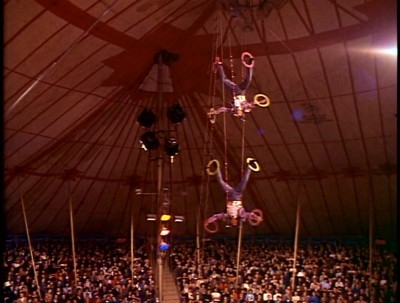
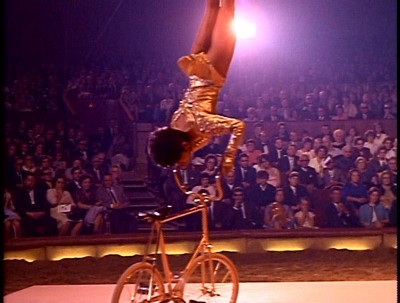
Next, Stockholm's Cirkus Scott is the venue for a remarkable balancing act by the incredible Marco, where he first balances two teetering plates of tall cocktail glasses on the handle end of a razor-sharp sword...only to balance the tip of that sword on the tip of a shorter sword he holds in his mouth...before he ascends a swinging ladder, only to lean all the way back, daring the sword to fall and plunge through his body. While wearing a tux (again: what balls). At the Circus Krone, we see some elephants dressed like The Beatles (for the kiddies in the audience, I guess), before we switch to world-famous Lilly Yokoi and her remarkable stunts on her gold-plated bicycle (no helmets or pads like the punks on the BMXs today...). Next, equally lovely Paulina Schumann jumps rope while her magnificent horse jumps obstacles, before the The Two Mascott sisters balance on each others' heads. Terry Martin and his wife, known here as Grey Arrow and Zuni, have an Indian arrow-shooting act that's pretty good (she looks a tad nervous during the William Tell bit, though). Next, the renowned Larible Bros. trapeze act is featured (enhanced by the "whooshing" of the trap bars), before the-then greatest juggler in the world, Rudy Cardenas ("the human mechanism pushed to its limits") executes a series of astounding juggling feats, including sticks, balls, cups, hats, and billiard balls thrown into the air and caught on his belt pockets (one of Rings Around the World's stand-out scenes).
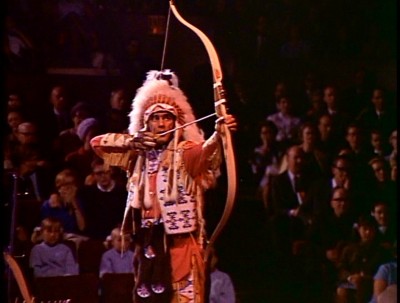
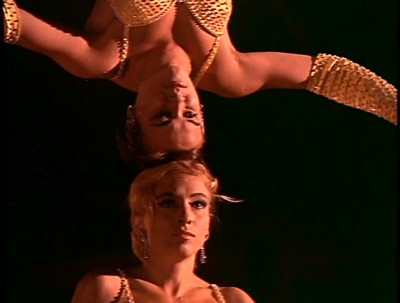
A brief stop-over in America--specifically the McKean County Fair in Pennsylvania--is the site of The Flying Armors, where Reggie executes a flawless triple--one of the few men doing this dangerous stunt at the time (I love seeing this out in the open, on those nostalgic old fairgrounds). Back in Europe, we're unfortunately subjected to that most hated element of the circus--no, not the horsesh*t but the clowns--in an ungodly protracted, painfully unfunny sequence that really saps the building energy of the doc...while foreshadowing the gradual decline in interest in what the rest of Rings Around the World has to offer. The Tongas aerial act is fine, but Fred Knie (of the famous Knie Circus) and his sleeping horse put me to sleep. Animal tamer extraordinaire Gunther Gebel-Williams (Sigfried and Roy only wish they were ever that cool) follows with a relatively tame show (the script makes the cardinal error of telling us the very next night after this filmed performance the tiger attacked him: don't jerk our chain with the promise of seeing something that sweet...and then not show us it). Gene Mendez and Joe Seitz wind things down with a familiar high-wire act that somehow comes off as more just plain gutsy than actually artfully executed (the backward jump roping is pretty impressive, though). Finally, as Neil Sedaka waits in the wings to sing The Canvas Sky over the end credits (jesus...), Don Ameche, with one eye glued to the cue cards, reads us out of Rings Around the World.
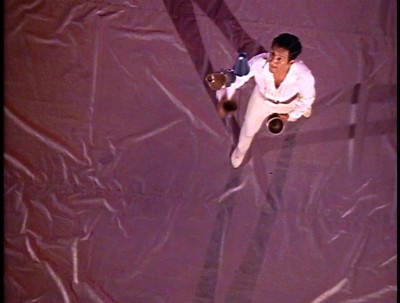
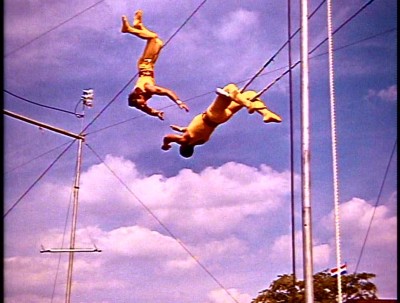
The Video:
I'm guessing that when Rings Around the World was shown in theaters, it was cropped in projection at 1.66:1. However, I'm also betting that the fullscreen, 1.37:1 image here is pretty close to what was originally shot, since it was probably done at the same time as the television show (and no doubt originally intended for broadcast on the small tube). Nothing looks egregiously cropped; all the framing looks spot-on, so I'm only going to take points off for the sometimes pinkish, faded color values, and the expected screen imperfections.
The Audio:
The Dolby Digital English mono audio track for Rings Around the World is acceptable, with low hiss, and no subtitles or closed-captions available.
The Extras:
No extras for Rings Around the World.
Final Thoughts:
Just nod along with Don Ameche as he fakes his way through writing a book about the circus, inbetween the mostly spectacular acts that are presented here in Rings Around the World. If these legendary performers were better caught doing their amazing acts on screen, I'm unaware of it, so if you're at all interested in this sort of thing, Rings Around the World--even with its b.s. fictional framework--comes highly recommended.
Paul Mavis is an internationally published movie and television historian, a member of the Online Film Critics Society, and the author of The Espionage Filmography.


|
| Popular Reviews |
| Sponsored Links |
|
|
| Sponsored Links |
|
|
| Release List | Reviews | Shop | Newsletter | Forum | DVD Giveaways | Blu-Ray | Advertise |
|
Copyright 2024 DVDTalk.com All Rights Reserved. Legal Info, Privacy Policy, Terms of Use,
Manage Preferences,
Your Privacy Choices | |||||||









